Shop
Showing 181–192 of 253 results

Kale
Mostly Red Russian a.k.a “Ragged Jack” Superb purple-veined, blue-green leaves with red-purple frilly leaf margins. Very hardy. Sow 3–4 seeds 30-45cm apart, 1cm deep, in rows 45-91cm apart. Thin to 1 plant per group, or grow as microgreens!
Approx 150+ seeds
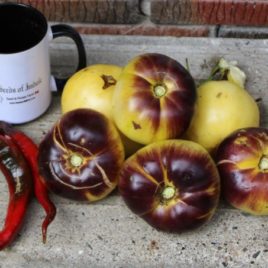
Large Mug – Seeds of IMBOLC
PICK UP ONLY
MADE BY A LOCAL WOMAN ENTREPRENEUR - SUPPORTING LOCAL BUSINESS! WITH THANKS!
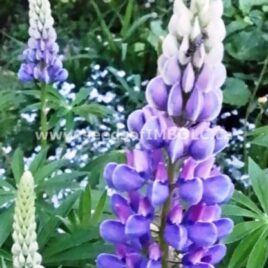
Lupin Mix
A member of the pea family, Lupins are a wonderful old-fashioned flower, with spires of blue, yellow, pink, purple, white, peach and bicolours.. Although they are perennials, lupins are in the class of short-lived perennials. They put all their energy into those magnificent flower stalks and wear themselves out in the effort. Lupins live in the range of two to five years, but luckily they will self seed and the butterflies and bumblebees will love you.
*All parts of this plant are poisonous, including the seeds. Exercise extreme caution around children and pets. The purchaser assumes all liability relating to the use of this product.
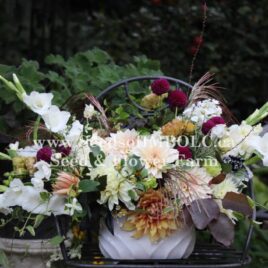
Lush Centrepiece Arrangement – August : Slow-Living Series
Saturday AUGUST DATE TBA 1-3:30 pm:
Dahlias are my specialty - come create with stunning dahlias & learn the art of crafting a sumptuous, naturally stunning, centrepiece, with the freshest summer blooms, harvested right at the farm. Foam & chemical free floristry.
If you have a wedding or event coming up in your future this would be a wonderful time to learn this timeless technique. You will create some floral magic yourself. No experience necessary for this fun, relaxing workshop. Let the floral creativity begin! These floral arrangements retail $300+
We will start off with a tour of the farm, which is normally closed to the public, answering your questions & seeing where & how the in-season flowers grow. A lovely time to enjoy being at the farm, surrounded by beautiful flowers and good company. After an in depth demonstration, participants will craft their own floral masterpieces in an attractive vessel to take home.
This is a single admission to join a 2.5 hour workshop with flower farmer & Master Gardener, Katherine Granger.
Learn about the dahlias I grow and how to pick and care for them. You will create a beautiful arrangement, start to finish, to take home with you. No floral experience necessary.
Hands-on learning experience, showcasing locally and sustainably grown elements. Explore your own style within the framework of guidelines demonstrated in these hands-on floral workshops and to ask questions about planting a flower garden of your own.
All classes are held at our flower farm in Centre Wellington Ontario. Upon registration, you will receive detailed information.
Workshop purchases are non-refundable. If the workshop does not reach a minimum of 5 participants, it may be cancelled in which case you will be fully refunded. No refunds or transfers are offered for students who can not make it after registering. In case of severe weather, the class may be rescheduled or cancelled. Students will be notified in advance as much as possible and refunds will be issued as needed if Seeds of Imbolc chooses to cancel a class.
Students must be 14 years or older to participate. We use sharp tools that are not appropriate for younger children.
Enjoy being part of the the entire process, seed to vase. Light refreshments will be provided.
Please bring your own gardening gloves if you require gloves.
All sales are final. Tickets are non-refundable, non-transferable, non-exchangeable. However, if you find that you are unable to attend the class, please by all means, give your spot to a friend.
What you’ll experience:- Flower arranging as mindfulness and meditation
- A walk through the gardens, be inspired by the flowers
- Colour theory and colour blending
- Different floral elements, shapes, and movement
- How to build an arrangement using foam-free mechanics
- Fun!
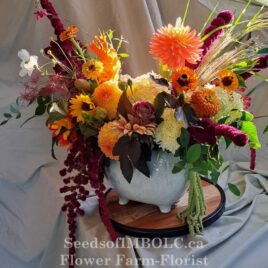
Lush Centrepiece Arrangement- July: Slow living Series
Saturday JULY DATE TBA 1-3:30 pm:
Dahlias are my specialty - come create with our stunning dahlias & learn the art of crafting a sumptuous naturally stunning centrepiece, with the freshest summer blooms, harvested right at the farm. Foam & chemical free floristry. If you have a wedding or event coming up in your future this would be a wonderful time to learn this timeless technique. You will create some floral magic yourself. No experience necessary for this fun, relaxing workshop. Let the floral creativity begin!
These arrangements can retail $300+
We will start off with a tour of the farm, which is normally closed to the public, answering your questions & seeing where & how the in-season flowers grow. A lovely time to enjoy being at the farm, surrounded by beautiful flowers and good company. After an in depth demonstration, participants will craft their own floral masterpieces in an attractive vessel to take home.
This is a single admission to join a 2.5 hour workshop with flower farmer & Master Gardener, Katherine Granger.
Learn about the dahlias we grow and how to pick and care for them, and then you'll be free to wander & pick whatever you'd like (really!) You will hands-on create a beautiful arrangement, start to finish, to take home with you.
Hands-on learning experience, showcasing locally and sustainably grown elements. Explore your own style within the framework of guidelines demonstrated in these hands-on floral workshops and to ask questions about planting a flower garden of your own.
All classes are held at our flower farm in Centre Wellington Ontario. Upon registration, you will receive detailed information.
Workshop purchases are non-refundable. If the workshop does not reach a minimum of 5 participants, it may be cancelled in which case you will be fully refunded. No refunds or transfers are offered for students who can not make it after registering. In case of severe weather, the class may be rescheduled or cancelled. Students will be notified in advance as much as possible and refunds will be issued as needed if Seeds of Imbolc chooses to cancel a class.
Students must be 14 years or older to participate. We use sharp tools that are not appropriate for younger children.
Enjoy being part of the the entire process, seed to vase. Light refreshments will be provided.
Please bring your own gardening gloves if you require gloves.
All sales are final. Tickets are non-refundable, non-transferable, non-exchangeable. However, if you find that you are unable to attend the class, please by all means, give your spot to a friend.
What you’ll experience:- Flower arranging as mindfulness and meditation
- A walk through the garden as you allow the flowers to inspire you
- Colour theory and colour blending
- Different floral elements, shapes, and movement
- How to build a bouquets/arrangements with foam-free mechanics
- Fun!
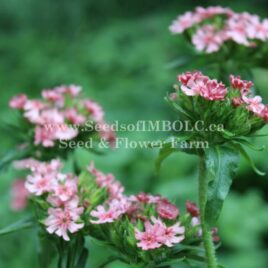
Lychnis Chalcedonica – ‘Dawn Sky’
Loving this Dusky pink Maltese Cross (Lychnis chalcedonica "Dawn Sky") Hardy fuss free & beautiful in a vase & in the garden Apricot-pink flower clusters bloom in early to mid-summer. (usually beginning of July here)
A rare heirloom, given old names such as Nonesuch and Mock Sweet William, it is a hardy survivor. Easy and pest free, it's showy grown in masses in the cottage garden. This could be the ‘pale red’ variation of the traditional bright scarlet maltese cross that was mentioned in Curtis’s Botanical Magazine in 1794.
Perennial Zone: 4,5,6,7,8
approx 75+ seeds
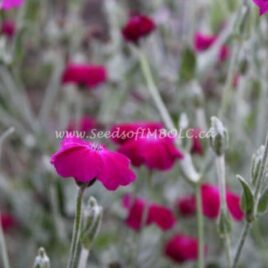
Lychnis coronaria aka Rose Campion
Circa 1828 - Mounds of silvery-green/grey, woolly stems and foliage with neon magenta flowers! What more could you ask of a flower???
Great as a cut flower!
A beloved old plant once called Mullein Pink and Lamp Flower, as the felted leaves once were used in the making of wicks. Its brilliant magenta colouring is electric in combination with the silver-gray leaves on branching stems. An easy to grow, long-blooming and low maintenance short-lived perennial or biennial. Most plants do not survive harsh winters after flowering but it does readily self seed to perpetuate a planting. Despite its short life span, it is certainly worth growing.
See more below...
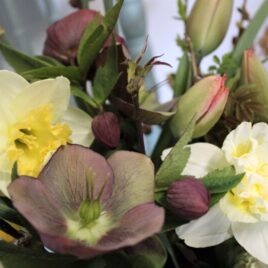
Mothers Day Hand tied Style Posie (smaller bouquet)
Paper-wrapped posie/bouquet with my own farm grown selection of beautiful, fresh, in-season blooms. (a.k.a 'Mason Jar' type)
A super economical way to enjoy fresh flowers! See our Instagram video and follow us for lots of free content!
Looking for something different? KAT@SEEDSOFIMBOLC.CA to let us know if you'd like to order something not found in the Flower Menu.
*Pictures are examples, flowers are the best of what is in -season.
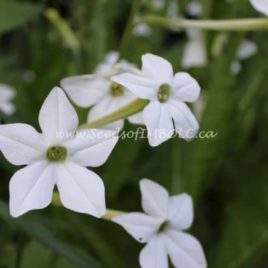
Nicotiana – Flowering Tobacco ‘Grandiflora’
Nicotiana alata One of the most fragrant flowers! This stunning plant is a must-have for every gardener and is ideal for the mixed border. Flowering for many months, it fills the air with a sweet, jasmine-like scent. Showy white flowers open during the cool of the evening with oblong shaped leaves and an erect branching form. Hummingbird moth magnet! aka Jasmine tobacco produces tall, graceful stems of pale, nodding flowers with starry faces. Its soft, sweet perfume peaks at dusk on warm nights; their pale, luminous flowers often open in the evening, so tuck plants near a window to get their Jasmine-like perfume indoors.
Recommended variety by Erin at Floret.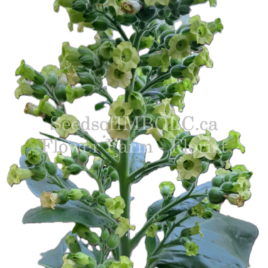
Nicotiana rustica ‘Aztec Flowering Tobacco’
Nicotiana rustica This broad-leaved plant is quite unassuming until it shoots up thick stems loaded with acid green bell-shaped blooms. The versatile colour works with nearly every colour palette and the tall stems are a perfect filler for large-scale arrangements and pollinators seem to like them too.
Bouquet approved by Erin B at Floret!
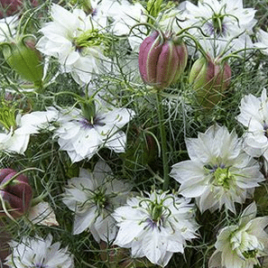
Nigella ‘Cramers Plum’
Nigella 'Cramer's Plum'
Hardy Annual. Attracts pollinators. Produces double white flowers with dark purple seed pods that can be used in fresh or dried arrangements.
They excel as long-lasting cut flowers (7 days esp with preservative) A hardy early bloomer in the garden with brilliant ferny leaves and lacy, star-shaped flowers are framed by a delicate halo of fringed foliage. aka Spanish fennel flower native of southern Spain.
See below for more....
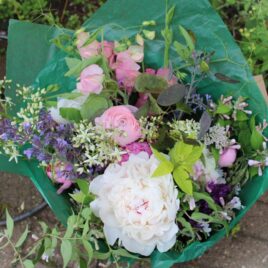
Once a month Flowers! Classic Style
Would you love to give or receive beautiful, chemical free, local flowers once a month beginning April/May (depending on Mother Nature) for 6 months? Enjoy the best the current season has to offer for 6 seasons! From Tulips, ranunculus, peonies, sweet peas, iris to dahlias and chrysanthemums. (and SO much more!)
Classic wrapped Bouquet size - a $60 value bouquet each month which means you are receiving one bouquet absolutely FREE. this is a wrapped bouquet not in a vase. Vases can be added on request.
My floral design style is natural and reminiscent of an English country herbaceous garden for your enjoyment. Bring nature in & let it shine - joy in a vase :-)
Pick up at our Farm in Fergus
Local Delivery can be arranged - contact us to discuss
